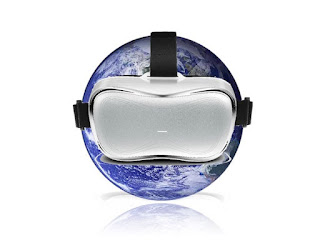When I first saw this technology on display, I knew I had to write about it. I knew our readers needed to
know about it, not just because this technology embodies two important trends
now impacting education, but also because you really want to try this with your
own children or grandchildren. Yes, it's that cool. Really.
This post is about VR for the
youngest among us. The crayon crowd. This project emerges from North Carolina
State University’s respected Immersive Experience Lab. One among many projects in this
lab is the Panoform project. Payod Panda, the lead designer and developer for the Panoform project,
explains the value proposition for their solution in this way: “When you think
of kids, they really want to create things, but there is no way for them to
create [easily] in VR right now.”

So how does Panoform work? Panda’s workflow explanation, along
with the pictures shown below, helps explain exactly how Panoform is quite
unique: "From our perspective, this is a tool which can let people create
VR environments in a really quick way. So you just sketch on the template we
have, you take a photo of it, you crop it, go to our website, and you then
upload that photo. On a desktop, the website allows you to view your
sketch on a flat screen, but the real magic happens when use your phone to do
it—after loading your sketch on your phone, just switch to VR mode and put it
in a VR viewer (like the Google cardboard). Instantly, you are teleported to
the center of the sketch you just created."

And here's the big change
for the crayon crowd: Panda continues: "This is a complete shift in the
way you look at a 'sketch'—you just went from creating a paper sketch, which is
typically a tiny window into a world you imagine, to an environment that you
are inside of and that you can look around in—all using paper and
crayons.”
Interestingly, Panoform is currently provided to schools,
educators, and in my case—grandparents—free of charge. Considerable
thoughtfulness has been applied to this product in its design, at least for
education, in that schools can create their own private directories for storage
of student work. Aside from being a tool for
artistic VR creation, the Panoform team is also thinking of ways for using the
tool in middle- and high-school curricula for subjects that can benefit from
the modaility of spatial thinking.
Panoform represents a continued and formidable echo of
the user-generated content theme, albeit at a much lower grade level. Panda
explains: “Our main idea is to get more kids to become ‘creators’ of the art
form more than ‘consumers’ of the art form.” Although the technology is neither
new nor proprietary, it also represents a creative 'rethinking' of existing
technology. No doubt, we are increasingly in the business of producing little geniuses.
































